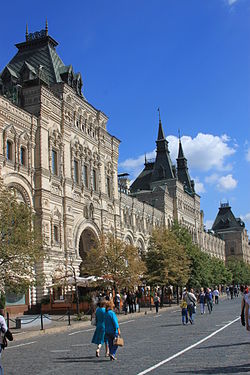- GUM (department store)
-
GUM (Russian: ГУМ, pronounced as goom, as abbreviation of the Russian: Главный универсальный магазин Glavnyi Universalnyi Magazin, meaning "main universal store") is the name of the main department store in many cities of the former Soviet Union, known as State Department Store (Russian: Государственный универсальный магазин, Gosudarstvennyi Universalnyi Magazin) during the Soviet times. Similar-named stores were in some Soviet republics and post-Soviet states. The most famous GUM is a large store in the Kitai-gorod part of Moscow, facing Red Square. It is actually a shopping mall. Prior to the 1920s the place was known as the Upper Trading Rows (Russian: Верхние торговые ряды).
Moscow GUM
With the façade extending for 242 m (794 ft) along the eastern side of Red Square, the Upper Trading Rows were built between 1890 and 1893 by Alexander Pomerantsev (responsible for architecture) and Vladimir Shukhov (responsible for engineering). The trapezoidal building features an interesting combination of elements of Russian medieval architecture and a steel framework and glass roof, a similar style to the great 19th century train stations of London. Nearby, also facing Red Square, is a very similar building, known formerly as the Middle Trading Rows.
 Inside the store during 1893: elongated shop galleries are bridged with innovative metal-and-glass vaults, designed by Vladimir Shukhov
Inside the store during 1893: elongated shop galleries are bridged with innovative metal-and-glass vaults, designed by Vladimir Shukhov
The existing structure — defined by William Craft Brumfield as "a tribute both to Shukhov's design and to the technical proficiency of Russian architecture toward the end of the 19th century" — was built to replace the previous trading rows that had burnt down during 1825. The glass-roofed design made the building unique at the time of construction. The roof, the diameter of which is 14 m (46 ft), looks light, but it is a firm construction made of more than 50,000 metal pods (about 819 short tons (743 t), capable of supporting snowfall accumulation. Illumination is provided by huge arched skylights of iron and glass, each weighing some 820 short tons (740 t) and containing in excess of 20,000 panes of glass. The facade is divided into several horizontal tiers, lined with red Finnish granite, Tarusa marble, and limestone. Each arcade is on three levels, linked by walkways of reinforced concrete.
By the time of the Russian Revolution of 1917, the building contained some 1,200 stores. After the Revolution, the GUM was nationalised and continued to be used as a department store until Joseph Stalin converted it into office space in 1928 for the committee in charge of his first Five Year Plan. After the suicide of Stalin's wife Nadezhda during 1932, the GUM was used briefly to display her body.
After reopening as a department store during 1953, the GUM became one of the few stores in the Soviet Union that did not have shortages of consumer goods, and the queues of shoppers were long, often extending entirely across Red Square.
At the end of the Soviet era, GUM was partially then fully privatized, and it had a number of owners before it ended owned by the supermarket company Perekryostok. During May 2005, a 50.25% interest was sold to Bosco di Ciliegi, a Russian luxury-goods distributor and boutique operator. As a private shopping mall, it was renamed in such a fashion that it could maintain its old abbreviation and thus still be called GUM. However, the first word Gosudarstvennyj ('state') has been replaced with Glavnyj ('main'), so that GUM is now an abbreviation for "Main Universal Store".
It is still open nowadays, and is a popular tourist destination for those visiting Moscow. Many of the stores feature fashionable brand names familiar in the West; locals refer to these as the "exhibitions of prices", the joke being that no one could afford actually to buy any of the items displayed. As of 2005, there were approximately 200 stores.
There is a similar historic department store that rivals GUM in size, elegance and opulent architecture named Central Universal Store (Tsentralniy Universalniy Magazin, abbreviated as TsUM). It sprawls just east of the Bolshoi Theatre.
External links
Structure of Shukhov's roof
- GUM official website (English)
- GUM at Structurae
- Vladimir Grigorievich Shukhov
- Fausto Giovannardi: "Vladimir G. Shukhov e la leggerezza dell’acciaio" (Italian)
- The Roof of GUM
References
- William Craft Brumfield: "The Origins of Modernism in Russian Architecture", University of California Press, 1991, ISBN 0-520-06929-3.
- Elizabeth Cooper English: “Arkhitektura i mnimosti”: The origins of Soviet avant-garde rationalist architecture in the Russian mystical-philosophical and mathematical intellectual tradition”, a dissertation in architecture, 264 p., University of Pennsylvania, 2000.
- Rainer Graefe, Jos Tomlow: “Vladimir G. Suchov 1853-1939. Die Kunst der sparsamen Konstruktion.”, 192 S., Deutsche Verlags-Anstalt, Stuttgart, 1990, ISBN 3-421-02984-9.
Coordinates: 55°45′17″N 37°37′17″E / 55.75472°N 37.62139°E
Categories:- Department stores of Russia
- Department stores of the Soviet Union
- Buildings and structures in Moscow
- Roof structures by Vladimir Shukhov
- Visitor attractions in Moscow
- Soviet brands
- Buildings and structures completed in 1893
- Red Square
Wikimedia Foundation. 2010.





